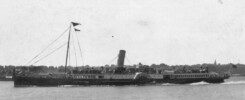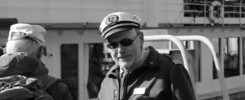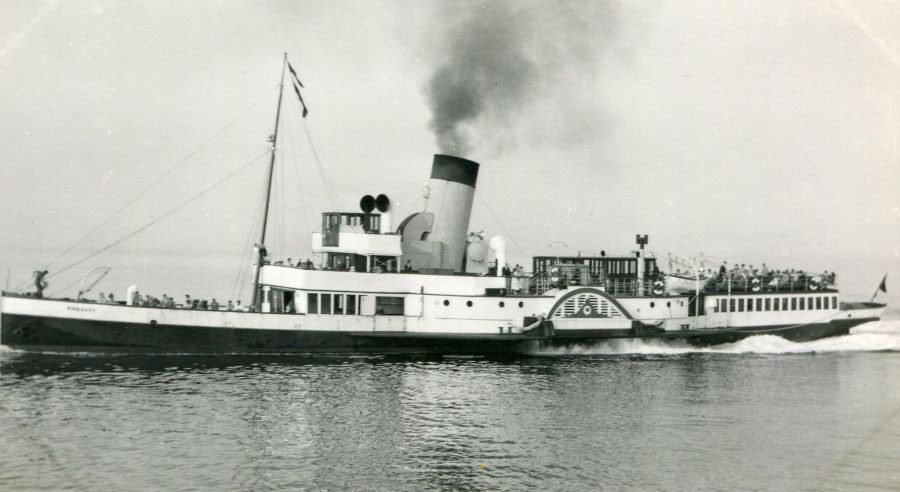
Friday October 1st was the last day of scheduled sailings for the Embassy in 1953.
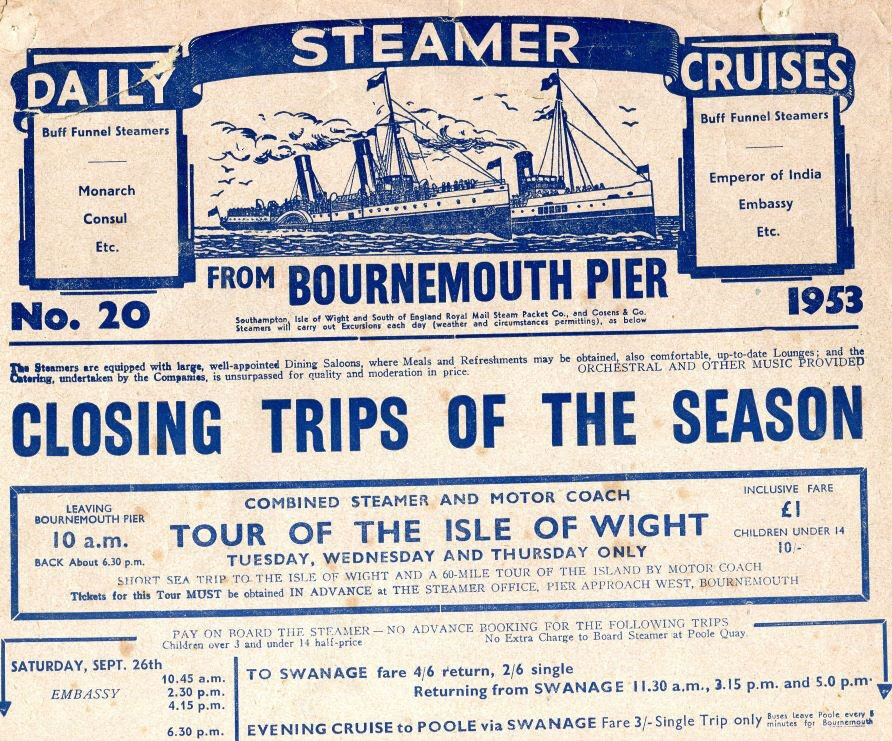
I like the masthead for these Cosens’s Bournemouth steamer notices from the 1950s. I think that the picture has great promotional power and conjures up well the atmosphere of going afloat by paddle steamer. The sharp eyed amongst you will already have twigged that the two steamers portrayed were not in fact ever owned by Cosens but had belonged to Cosens’s parent company Red Funnel. In the foreground is one of the pair Lorna Doone or Solent Queen which were acquired by Red Funnel in 1948. In the background is the Bournemouth Queen as rebuilt after the Second World War. By 1953 both Lorna Doone and Solent Queen had been withdrawn and scrapped and Bournemouth Queen had lost her sea-going Class III BOT Passenger Certificate and sailed only within the Solent from Southampton. But I don’t think any of that really mattered. It is a good picture with a good message.
As you will all know, there are two basic types of printed advertising material: that used for promotion and that used for information and they are very different beasts. Promotional material needs to sell an idea and sow the seeds of a dream in people’s minds. It should be simple, restricted in the number of words it uses and should have a powerful message which engages. For example, the railway companies were good at producing posters which could go up on any railway station anywhere advertising, say, Skegness or Bournemouth or the River Dart or wherever. They contained a heading, a powerful picture, only a short sentence of copy and contact details. That was it. They were designed to make people in distant locations want to travel and to buy the product on sale elsewhere.
By the time that people arrived in the resorts the paddle steamers didn’t really need promoting. They promoted themselves. There they were open to view coming and going from the piers which were always at the heart of any resort. Nobody arriving in Bournemouth, Weymouth, Brighton, Ilfracombe, Dartmouth or wherever could have been in any doubt that there were paddle steamers running trips. They could see them. They promoted themselves.
What the companies did need to do was to produce steamer notices which gave information. When were the trips? How much did they cost? Where did they go and so on? Inevitably these steamer notices were therefore more wordy and densely written. Some companies, for example on the Thames, often had one steamer notice for the whole season with the same trips being offered on the same days of the week, each week. Some, for example Cosens and Red Funnel, changed their steamer notices every week or fortnight which gave them the opportunity to add special trips to take advantage of local happenings, for example, to put passengers aboard, say, a visiting warship or to view a particular liner, like the Queen Mary at Southampton. Some, like P & A Campbell were forced to produce steamer notices of unrelenting complexity as their trips were dependent on the vast Bristol Channel tides.
Whilst promotional and informational printed material are very different beasts sometimes the operators combined a little bit of promotion just to whet the appetite with the more important function of the steamer notices of giving the information on the trips offered. And that is what Cosens was doing here.
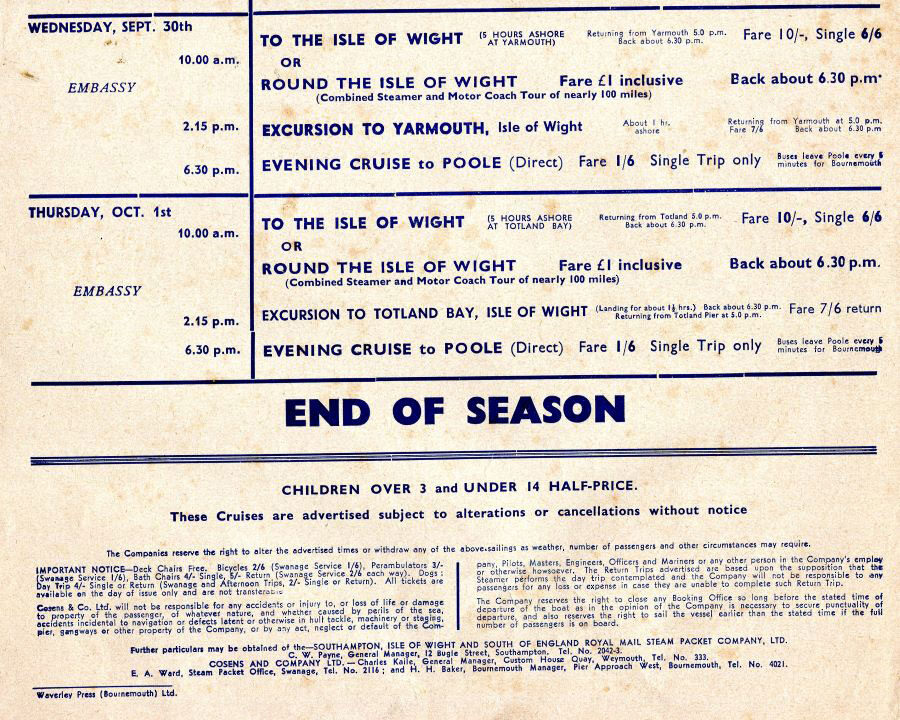
On Friday October 1st Embassy was rostered to leave Poole at 8.30am for a departure from Bournemouth Pier at 10am for a day trip “To the Isle of Wight” or “Round the Isle of Wight”. Note that the “Round the Isle of Wight” bit was by motor coach from Totland Bay and was not on Embassy. On the one hand this appears to contradict an important rule for any company of trying not to give away any of your revenue to third parties like coach operators. But on the other, and in this case, it worked. Cosens was getting a day trip fare for what was in fact only an hour and a half’s steaming each way from Bournemouth to the Isle of Wight. If Embassy was full then she just stayed alongside all day not burning fuel waiting for her passengers to return at 5pm. Or if she was not full then she came back to Bournemouth for another bite of the cherry offering an afternoon cruise at 2.15pm to the Isle of Wight. It was a perfect business model. And with Cosens keeping their own mark up on the motor coach fare round the Island it was an ideal formula which maximised revenue and minimised operational costs.
With inflation raging over the years, by 1963 Embassy’s day trip fare from Bournemouth to the Isle of Wight had risen to 18/-. With an add on coach tour round the Island of 8/6 this gave a total adult fare for the full day out of 26/6. Contrast that with the 1963 day return fare on Medway Queen from Strood to Herne Bay. This trip had a steaming time of around three and a half hours each way, more than twice that of Embassy’s day trip. For this the New Medway Steam packet Company charged just 11/- return.
I admire Cosens. They had a good commercial eye.
Kingswear Castle returned to service in 2023 after the first part of a major rebuild which is designed to set her up for the next 25 years running on the River Dart. The Paddle Steamer Kingswear Castle Trust is now fund raising for the second phase of the rebuild. You can read more about the rebuilds and how you can help if you can here.
John Megoran

